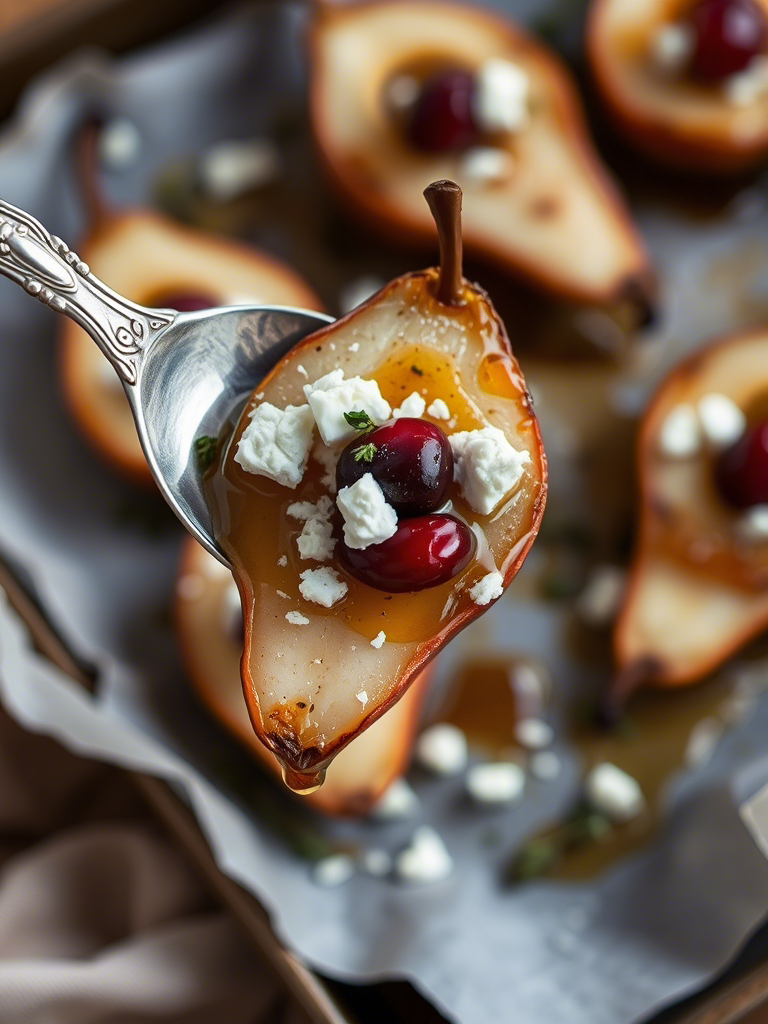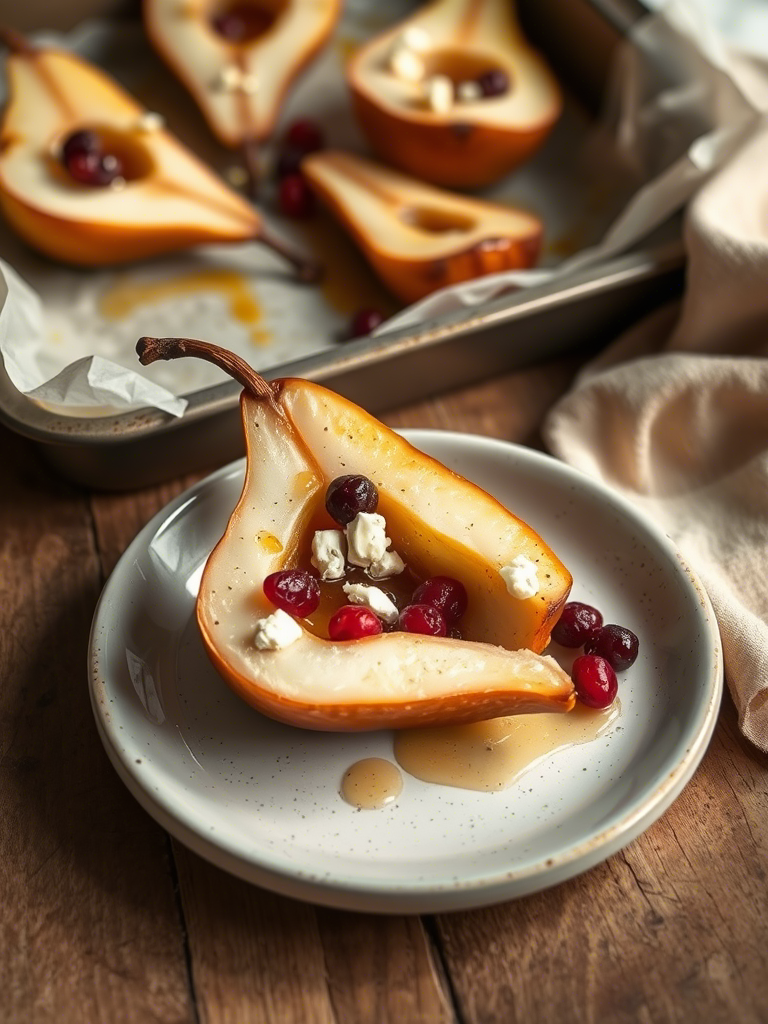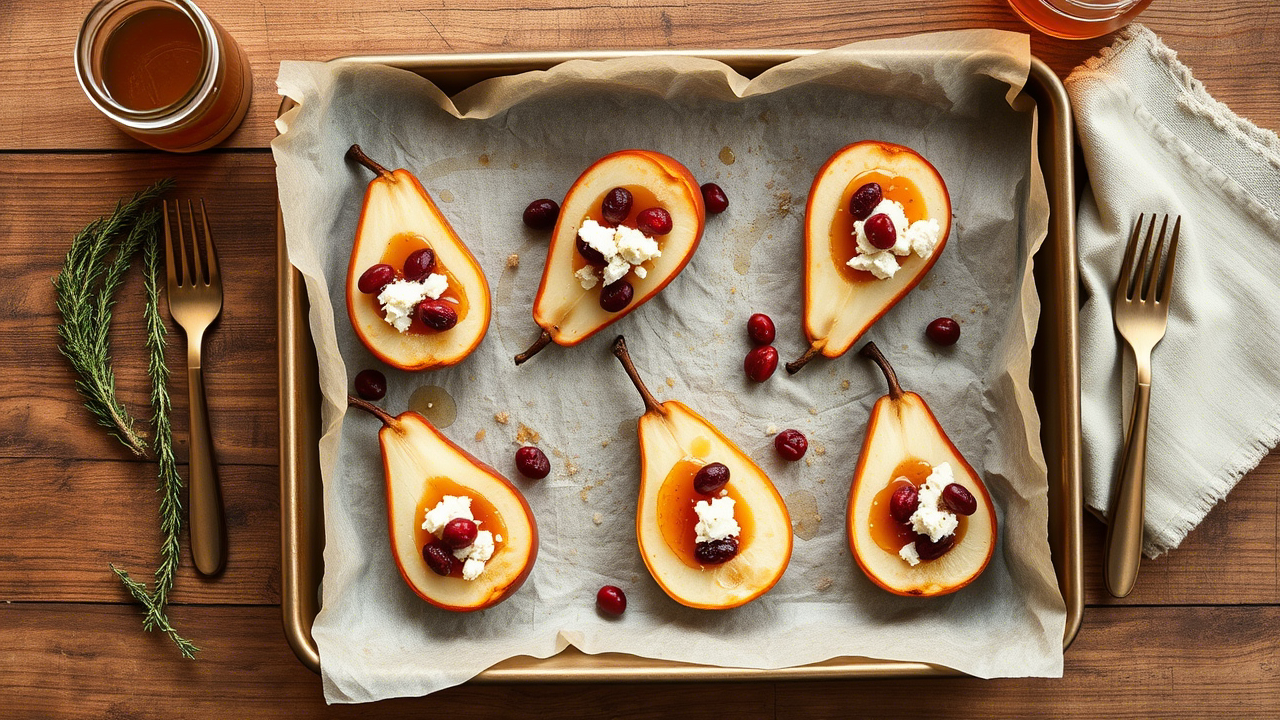The kitchen is the one place where contradiction thrives. Where you can throw together ingredients that shouldn’t work together—and somehow, they sing. Baked pears with feta, honey, and cranberries? That’s exactly one of those quiet little miracles. It’s rustic. Elegant. Earthy. And outrageously good when done right.
This dish isn’t about showing off, but it does. It plays with texture, balance, and temperature in a way that both chefs and home cooks love messing with. It’s a dish that works for brunch, dinner parties, or dessert. Yeah, you read that right—dessert with cheese. Let’s pull this apart and talk about why it works, and more importantly, how to make it perfectly every damn time.
The Science of Flavour: Why Pear + Feta + Honey + Cranberries Works
If you ask any chef worth their apron, they’ll tell you flavor is about contrast. Not complexity for complexity’s sake. Contrast. Pears are sweet, juicy, soft. Feta is salty, crumbly, sharp. Honey brings in warm, floral notes. Cranberries? They punch you with tartness and chew. Together—it’s like a string quartet where every player knows when to step back.
There’s also texture play. The soft roasted pear against the slight crunch of toasted nuts (yep, more on that soon), the bite from cranberries, and that smooth drizzle of honey pooling over warm cheese. It’s like the dish tells a story in stages.
What makes this dish even more fascinating is its versatility with pairings and applications. Serve it over a bed of baby arugula and it’s a salad. Nestle it next to roasted chicken and now it’s a side. Want it as dessert? Just add a touch more honey and a scoop of mascarpone. Done.
Selecting the Right Pears: It Matters More Than You Think
Don’t reach for any pear and call it a day. That’s rookie stuff. You need a firm-fleshed variety that holds its shape while baking. Bosc or Anjou are your friends here. Bartletts? They collapse into mush and ruin your plating game.
Look for pears that are just barely ripe. Not soft. They should give a tiny bit under pressure near the stem. That’s it. Too ripe and you’re baking applesauce with feta. Not what we’re doing here.
Peel or not to peel? Depends. Keeping the peel on helps the pear hold up better and adds visual interest. But if you’re chasing that melt-in-your-mouth feel, peel ’em. Both ways work. It’s more about what your final dish wants to say.
Feta: Sharp, Salty, And Not All Made Equal
Let’s talk feta. That crumbly white block isn’t just one thing. Greek feta, traditionally made from sheep’s milk or a blend of sheep and goat’s milk, is tangier and creamier. American-style feta (often cow’s milk) is firmer and a little more muted.
For this dish, Greek-style feta is where the magic is. The sharp, briny pop cuts through the sweetness of pear and honey like a whisper of thunder. But avoid pre-crumbled feta. It’s dry, lacks punch, and is often coated with anti-caking agents. Get the block. Crumble it yourself. Trust.
If you want to get cheeky, try a whipped feta variation. Blend feta with a little Greek yogurt and olive oil until it’s creamy as mousse. Dollop that onto warm pears. People will stare. Then they’ll ask for the recipe.

Honey: Not All Gold is Equal
Here’s a hot take. Most supermarket honey tastes like corn syrup wearing a floral wig. For this dish, quality honey matters. Go local if you can. Wildflower, orange blossom, or clover honeys work beautifully, depending on what direction you want to take.
Orange blossom honey will lean citrusy and fresh. Wildflower adds complexity. Clover’s classic and clean. Heat mellows honey’s nuances, so reserve the drizzle for just before serving. Let it kiss the pears. Not drown them.
Cranberries: Fresh, Dried, or Jammy?
Dried cranberries are the easy default. They’re chewy, tart, slightly sweetened. But don’t just toss them on like confetti. Rehydrate them in a splash of warm water or orange juice for 10 minutes before use. Makes them plumper and brighter. Some pros even soak ‘em in a dash of red wine or port. Now that’s a vibe.
If you’re bold, you can use a spoonful of cranberry compote instead. Especially great around the holidays when everyone’s making it anyway. Spoon some on the side or swirl into the feta. Adds that jammy depth that feels both fancy and homey.
The Nuts and Seeds Debate
Okay, so this isn’t technically in the title, but let’s be honest—textural contrast is the unsung hero. Toasted walnuts, pecans, or even pine nuts bring the crunch. You want that. Toss ’em in a dry pan for a few minutes until they’re fragrant. Watch ‘em like a hawk. Burned nuts taste like regret.
You could sprinkle some sesame seeds or crushed pistachios too. Or skip nuts entirely for an allergy-friendly take. But if your guests are game, nuts push the dish into that gourmet sweet spot.
Aromatics and Extras: Optional But Game-Changing
A tiny hit of cinnamon or ground cardamom on the pears before roasting? Yes please. Adds warmth without being cloying.
Rosemary or thyme? Sounds weird—until you try it. Fresh rosemary minced super-fine, added right before serving, balances the sweetness and sharp feta.
And black pepper. Yep. A few grinds over the finished dish make everything sing louder. Salty, sweet, tart, spicy—it’s fireworks in slow motion.
Cooking Technique: Temperature, Timing, and Touch
Start by halving your pears and scooping out the seeds with a melon baller or spoon. Brush lightly with olive oil or melted butter. Don’t go crazy.
Preheat oven to 375°F (190°C). Place pears cut-side up on a baking dish lined with parchment or greased lightly. Bake for 20–25 minutes or until a knife slides in with just a little resistance. You want them tender, not collapsed.
Five minutes before they’re done, sprinkle with feta and cranberries. Slide ‘em back in to soften the cheese just slightly and warm the cranberries.
Remove. Drizzle honey while warm. Add herbs or nuts. Serve immediately or let cool to room temp—it’s flexible like that.
Real-World Uses: From Michelin Plates to Meal Prepping
Here’s the thing—this dish isn’t just a side or a dessert. It’s a foundation. High-end restaurants use this combo as a base for crostini, pairing it with balsamic reduction or prosciutto. Wedding caterers love it for plated starters.
I’ve even seen a chef add shaved truffle over the top. Sounds excessive? Maybe. But I won’t judge.
At home, this is a meal-prep win. Roast a batch of pears, store them in the fridge. They’ll last 2–3 days. Pull one out, warm it up, throw on some cheese and nuts, done. That’s lunch with zero stress.

Nutritional Breakdown: More Balanced Than It Looks
Let’s break down the numbers, roughly per serving (half a pear with toppings):
- Calories: ~180–220
- Protein: ~4g (mostly from feta)
- Fat: ~8–10g (cheese, nuts, oil)
- Sugars: ~15–18g (natural + honey)
- Fiber: ~3g
So yeah, it’s sweet. But not junk. There’s fiber, protein, and healthy fats to keep blood sugar from spiking wildly. Use less honey if you’re watching sugars. Skip nuts if watching fats. Totally customizable.
Addressing Common Questions
Can I make this vegan?
Yup. Swap feta with a vegan cashew cheese or almond ricotta. Use agave or maple syrup instead of honey.
Can it be served cold?
Yes, though room temp is best. Cold pears dull the flavors a bit. But still good, especially in a salad.
Can I prep it ahead?
Absolutely. Roast the pears ahead. Keep components separate. Assemble and warm just before serving.
Is this a seasonal dish?
Best in fall and winter when pears are peak. But can be made year-round if you can score good fruit.
Final Thoughts: When Simplicity Hides Genius
There’s a kind of quiet genius in baked pears with feta, honey, and cranberries. It doesn’t scream for attention. It whispers. And if you listen, it teaches you something about balance, patience, and the wild beauty of simple ingredients handled with care.
Whether you’re plating for guests, feeding yourself after a long shift, or experimenting in a test kitchen—this dish always gives back.
If you’re not already using it in your rotation, maybe it’s time. Try it once. Then tweak. That’s how we grow. One bite at a time.
Because some of the best dishes? They don’t need fireworks. They just need the right hands.
FAQs
What type of pear is best for baking in this dish?
Bosc or Anjou pears work best as they hold their shape during baking.
Can I use pre-crumbled feta?
It’s better to use block feta and crumble it yourself for better texture and flavor.
Is this dish served hot or cold?
It’s best served warm or at room temperature for full flavor impact.
Can I make this dish ahead of time?
Yes, you can roast the pears ahead and assemble before serving.
Is this a dessert or a side dish?
It can be both—serve as dessert with more honey or as a savory starter with herbs.
What kind of honey should I use?
Use high-quality honey like wildflower, clover, or orange blossom for rich flavor.
Are dried cranberries necessary?
They’re preferred, but fresh or compote-style cranberries can also work.
Can I make it vegan?
Yes, swap feta with vegan cheese and honey with maple or agave syrup.
Do I need to peel the pears?
Not necessarily—peeling is optional and depends on your texture preference.
How long should I bake the pears?
Bake at 375°F for 20–25 minutes until just tender, not mushy.

Mariana is a passionate home cook who creates delicious, easy-to-follow recipes for busy people. From energizing breakfasts to satisfying dinners and indulgent desserts, her dishes are designed to fuel both your body and hustle.
When she’s not in the kitchen, she’s exploring new flavors and dreaming up her next recipe to share with the Foodie Hustle community.

